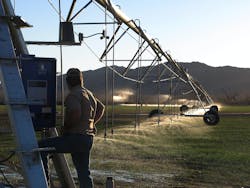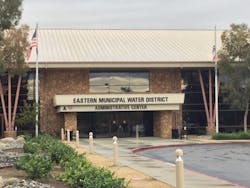Smart Utility Network: Service & Sustainability
About the author:
Dan Pinney is vice president of global water product management for Sensus, a Xylem brand. Pinney can be reached at [email protected].
For most of 2020, the COVID-19 pandemic has put a spotlight on some of the water industry’s most pressing challenges. Residential demand is higher as people work from home while commercial and industrial use is lower—both of which represent new usage patterns and an impact on revenue. As an essential service provider, the pressure is on for utility or municipal leaders to sustain operations and keep their staffs safe through workforce rotations, social distancing and providing protective gear. Pandemic or not, the need to conserve water never goes away.
Fortunately, balancing these challenges is achievable. Customer service, operational efficiency and sustainability are inextricably linked. A smart utility network can provide insights for utilities across today’s operational demands as well future applications.
In a recent report, the American Society of Civil Engineers found that the United States lost an estimated $21 million of treated water in 2019 due to leaks, with that number expected to more than double by 2039. Smart technology investments help utilities target water loss and empower customers with essential data to become water savvy. Southern California’s Eastern Municipal Water District (EMWD), provides an excellent example of customer focus and conservation with its smart utility network.
Advancing Service & Sustainability
Cyclical water shortages are a challenge that EMWD takes seriously. As the sixth-largest retail water agency in the state, they embrace the opportunity to balance water use efficiency with meeting the needs of a diverse and growing customer base.
Located in western Riverside County, California, EMWD provides water and wastewater services to nearly one million residents across a 555 square mile area. At just 38% capacity based on local land use plans, EMWD anticipates significant population growth in the coming decades and must balance its current demands with those of the future. To support this evolution, the utility is leveraging the smart technology that has supported it through its transition from manual meter reads to a smart utility network.
“Our board has shown unwavering support for our smart meter program, and its success would not have been possible without their commitment to creating a more efficient model that provides direct benefits to our customers,” said EMWD Meter Services Manager David Gayneaux. “Because of the resources our board has provided, we have been able to provide our customers reliable, accurate water use information in an economically sustainable manner.”
A Customer-First Approach
The water provider’s metering infrastructure has always gone hand-in-hand with customer service. It was a natural decision to invest in a smart utility network to streamline efficiency, promote sustainability and improve customer service across its coverage area.
“We wanted a system that would give us operational advantages and more,” Gayneaux said. “That meant a solution to help us push out new capabilities and enhance existing services so customers could see the benefits.”
EMWD deployed the two-way Sensus FlexNet communication network as part of a meter replacement program to enable remote monitoring and management. The utility now manages more than 158,000 meters, including iPERL residential and OMNI commercial meters. In just a short time, the utility has improved its leak detection capabilities and enhanced daily interactions with customers.
“We’ve used our network to proactively help more than 54,000 customers address issues with continuous usage,” Gayneaux said. “In addition, hourly usage data, available through EMWD’s ‘My Account’ customer portal, provides customers with the ability to self-serve and monitor their own water use. This also helps us answer day-to-day billing questions and provides customers with insights to understand their water consumption.”
Responding to the Pandemic
EMWD is streamlining operations as it progresses with its metering upgrade.
“We have four employees working on meter management where we previously had 16 people,” Gayneaux said. “We’ve reassigned staff to other tasks and projects to advance customer service.”
The benefits of operational efficiencies—combined with the flexibility of remote meter monitoring—have proven invaluable as EMWD deals with challenges from the COVID-19 pandemic, allowing it to better adhere to social distancing requirements.
“We don’t have to deploy technicians in the field as often to respond to the needs of the community,” Gayneaux said. “Having access to accurate, real-time data allows us to answer questions and service customers without the need for an in-person visit.”
Recycle & Reuse
EMWD is widely regarded as one of the nation’s leading recycled water agencies. Smart technology has also benefited its recycled water customers. EMWD currently treats 45 million gallons of wastewater each day, turning it into tertiary-treated recycled water. EMWD uses 100% of that recycled water for beneficial reuse during normal years, about two-thirds of which is used for agricultural production. Recycled water is also used for schools, parks, golf courses and public landscaping.
“Non-residential customers in agriculture, parks and schools all rely on recycled water as a sustainable, cost-effective resource,” Gayneaux said. “Our smart water network helps us oversee the distribution of water resources and consult with customers to make sure they’re getting the best value.”
In 2018, EMWD received a $210,000 grant from the United States Bureau of Reclamation to support new technology to allow agricultural users to track their water use in real time, including comparing actual usage to their yearly allocation of recycled water.
“We can set up weekly reports to help customers stay on track with their goals,” Gayneaux said. “It’s a big factor in why we’re achieving nearly 100% reuse of our recycled water.”
No Slowing Down
Water use efficiency and customer service remain the priority for EMWD as it advance its smart water system. The utility is now expanding its solution with the rollout of Sensus ally meters on residential accounts, allowing technicians to expand remote management capabilities while enhancing leak detection capabilities.
“We always look for ways to expand services to benefit our customers,” Gayneaux said. “Our ability to keep finding these scenarios that are mutually beneficial for both our customers and EMWD is only possible with our Sensus smart utility network.”
Conclusion
EMWD showcases improved customer service, operational efficiency and sustainability through the use of smart technology. They are well positioned to take on whatever comes next for their customers and community.

